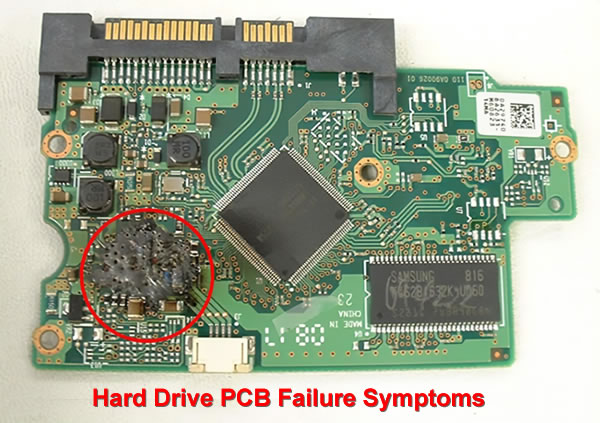A hard disk drive (HDD) is a crucial component of modern computing systems, storing vast amounts of data for various purposes. However, like any electronic device, an HDD can fail due to various reasons, such as physical damage, logical errors, or component malfunctions. One of the most common types of HDD failure is the Printed Circuit Board (PCB) failure, which can cause various symptoms that affect the drive's performance and data accessibility. In this post, we will discuss some of the most common symptoms of hard drive PCB failure and how to identify them.

Before we proceed, let's briefly explain what a PCB is and what it does in an HDD. A PCB is a small circuit board that connects the various components of an HDD, such as the platters, the read/write heads, the motor, and the interface ports. The PCB also contains a firmware chip that controls the drive's operations and stores critical data such as the drive's serial number, capacity, and firmware version. When a PCB fails, it can cause one or more of these components to malfunction, leading to data loss or corruption.
So, what are the symptoms of hard drive PCB failure? Here are some of the most common ones:
1. The drive does not spin up or make any noise when powered on: This symptom indicates that the motor or the power supply circuit on the PCB has failed. Without a functioning motor, the platters cannot spin, and the read/write heads cannot access the data.
2. The drive makes clicking or buzzing noises: These noises are often a sign of a malfunctioning read/write head or a misaligned spindle motor. However, they can also indicate a problem with the PCB's power supply or firmware chip.
3. The drive is not recognized by the computer or shows incorrect capacity: This symptom can occur due to various reasons, but a faulty PCB is one of them. If the firmware chip on the PCB is damaged or corrupted, it may report incorrect capacity or prevent the drive from being detected by the operating system.
4. The drive produces read/write errors or bad sectors: These errors can occur due to various reasons, but a damaged PCB can cause them by sending incorrect signals to the read/write heads or failing to regulate the power supply to the platters.
5. The drive emits smoke or burning smell: This symptom is rare but can occur if there is a short circuit or overheating on the PCB. In this case, you should immediately turn off the drive and seek professional help.
If you experience any of these symptoms, you should stop using the drive immediately and seek professional data recovery services. Attempting to repair or replace the PCB yourself can cause further damage and reduce the chances of successful data recovery. A qualified data recovery technician can diagnose the exact cause of your HDD failure and recommend the best course of action based on your specific case.
In conclusion, hard drive PCB failure is a common and serious problem that can affect your data accessibility and integrity. By knowing the symptoms of PCB failure and taking prompt action, you can increase your chances of recovering your valuable data and avoiding further damage to your HDD. Remember to always back up your important data regularly and keep your HDD in a clean and stable environment to minimize the risk of hardware failure.




